Australian Pulse Bulletin
Desiccation and croptopping in pulses
Desiccation and croptopping are well established techniques to improve the rotational fit, benefits and profitability of the pulse crop. While they are essentially the same physical operation of applying a desiccant herbicide close to final maturity of the pulse, they do achieve different objectives and must be applied with care. Windrowing may be considered as an alternative to desiccation. The timing of windrowing is similar to desiccation.
Quick reference guide for pulses and canola
-
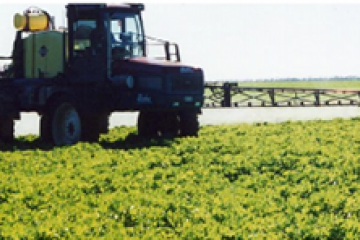
Desiccation and croptopping achieve different objectives
-
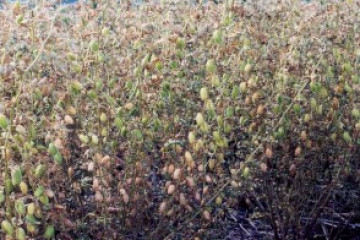
Croptopping is rarely possible in chickpea
-
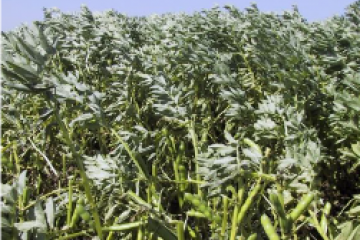
Faba bean is suited to desiccation, and to some extent croptopping
-
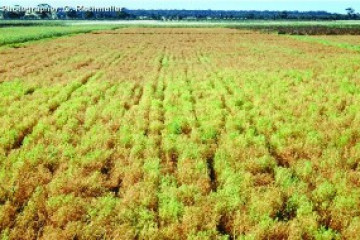
Lentil crops can benefit greatly from desiccation and croptopping
-
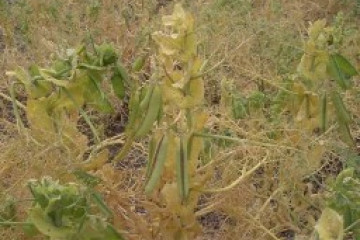
Do not desiccate or croptop field pea destined for the sprouting market
-
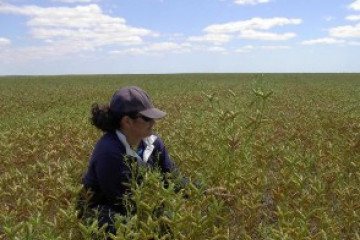
Yield reductions of about 5–10% can occur if the lupins are not fully mature
Purpose
Desiccation and croptopping are used to achieve different objectives.
Desiccation prepares the pulse crop for harvesting by removing moisture from plants and late maturing areas of the paddock.
Desiccation is an aid to a timely harvest, particularly where uneven ripening occurs across a paddock, and is now a common practice in lentil and chickpea. Desiccation enables a timely harvest to avoid weather damage. Application timing is based on the crop when the grain is 75% to 90% mature, to avoid reducing the quality of the harvested grain. Windrowing can be considered similar to desiccation in timing and benefits to harvest.
Croptopping aims to stop the seed set in surviving weeds without substantially affecting crop yield and grain quality. Croptopping is timed for the weed growth stage to control weed seed set from survivors of normal in-crop weed control. Croptopping cannot be used in all pulses.
It is effective in early maturing species like field pea and common vetch and early maturing varieties of narrow leafed lupins, e.g. Mandelup. It is also effective in drying off late maturing weeds to reduce high moisture or contamination of harvested grain.
Timing is aimed at the soft dough stage of the target grass weed species, typically annual ryegrass, to stop seed set. If radish is the target, the herbicide should be applied at the pre-embryo stage. In most crops, targeting radish exposes the crop to a heightened risk of crop damage.
When used correctly in the appropriate pulse species, the crop will be almost or fully mature and grain quality will be unaffected. Croptopping is part of an Integrated Weed Management strategy and should not be used as a sole strategy.
Timing
With correct timing, desiccation and croptopping can improve profitability in pulses.
The major differences between desiccation and croptopping are:
- Application timing is different and initiated by different criteria.
- Herbicides for croptopping and desiccation are not always the same.
- Herbicide rates for desiccation are higher than that required for croptopping.
- Croptopping will advance the harvest timing in some pulse crops.
- Neither desiccation nor croptopping can be used effectively in all pulses.
- Both will cause reduced grain quality and yield if applied at the wrong maturity stage of the crop.
Seed crops
Don’t risk a pulse crop for seed!
Desiccation and croptopping can affect seed viability if applied incorrectly. To avoid damaging seed viability, it is advisable not to desiccate or croptop a pulse seed crop. Field peas destined for the sprouting market, should not be desiccated or croptopped.
Treating crops
Which crops can you desiccate or croptop, and what should you use?
Pulse species differ in their time to maturity, making some unsuitable for croptopping. Croptopping is conducted before the target weed species mature, later maturing pulse species will be adversely affected.
Early maturing species such as field pea, lupin and vetch are well suited to croptopping. They will be close to maturity at the time of herbicide application, minimising the risk to yield and grain quality.
Chickpea and broad bean are late maturing species. Croptopping these will usually lead to unacceptable yield and quality problems as the grain will be too immature at the correct weed maturity stage.
With care, yield and quality losses can be minimised with croptopping, while desiccating at the correct maturity stage of the pulse will minimise any risk.
|
|
Desiccation | Croptopping |
|---|---|---|
| Desi chickpea | Yes, at 80-85% yellow-brown pods | No |
| Kabuli chickpea | Yes | No |
| Narrow leaf lupin | Yes (rarely warranted) | Yes |
| Albus lupin | Yes | No |
| Lentil | Yes | Yes |
| Field pea | Yes (rarely warranted) | Yes |
| Faba bean | Yes | Yes |
| Broad bean | Yes | No |
| Vetch | No | Yes |
| Mungbean | Yes | No |
Registered products
The following table details the registered herbicides for use when croptopping or desiccating pulses.
NOTE:- It is imperative that only registered products are used at label rates.
Exceeding maximum label rates will lead to the detection of chemical residues in excess of the allowable Maximum Residue Level (MRL) jeopardising market access and the future of the Australian grains industry.
| Herbicide
|
Example trade names
|
Operation
|
Crop
|
Rate
|
Withholding period
|
|---|---|---|---|---|---|
| Diquat 200g/L | Reglone® | Desiccation | Chickpea, faba bean, dry pea, lentil, lupin, mungbean | 2 to 3 L/ha | Grazing/stockfeed (GSF): 1 day
Harvest: 0 days (lupin, dry pea) 2 days (chickpea, lentil, faba bean) |
| Paraquat 250g/L | Gramoxone® | Croptopping | Chickpea, faba bean, field pea, lentil, lupin, vetch | 400 to 800 mL/ha | GSF: 1 day (7 days for horses) Stock must be removed from treated areas 3 days before slaughter
Harvest: 7 days |
| Glyphosate 480g/L | Ripper 480® | Croptopping | Faba bean, field pea | 360 to 765 mL/ha | GSF: 7 days
Harvest: 7 days |
| Desiccation | Chickpea, faba bean, field pea, lentil, mungbean | 765 mL to 2.025 L/ha | GSF: 7 days
Harvest: 7 days |
||
| Glyphosate 500g/L | Touchdown Hi Tech® | Croptopping | Faba bean, field pea | 300 to 700 mL/ha | GSF: 7 days
Harvest: 7 days |
| Glyphosate 540g/L | Roundup PowerMAX® | Croptopping | Faba bean, field pea | 320 to 680 mL/ha | GSF: 7 days
Harvest: 7 days |
| Desiccation | Chickpea, faba bean, field pea, lentil, mungbean | 680 mL/ha to 1.8 L/ha | GSF:7 days
Harvest: 7 days |
||
| Metsulfuron + Glyphosate 540 g/L | Ally® + Roundup PowerMAX® | Desiccation + knockdown weed control | Chickpea | 5 g + 500 mL to 1.1 L/ha | GSF: 7 days
Harvest: 7 days |
| Saflufenacil
|
Sharpen
|
Desiccation | Field pea, faba/broad bean,
chickpea, lentil, lupin |
34 g/ha plus recommended label rate of glyphosate or paraquat herbicide plus
1 % Hasten or high quality MSO |
GSF: 7 days
Harvest: 7 days |
GSF - Withholding period for grazing or cutting for stock food
Note: Observe the Harvest Withholding Period and GSF for each crop.
Glyphosate is not registered for seed crops and should not be used in pulses intended for seed production or sprouting.
Controlling annual ryegrass
Getting the best result from croptopping for the control of ryegrass is a race between the maturity of the crop to avoid yield and quality losses, and the latest possible time before the ryegrass seeds mature to ensure that all have emerged. A typical result is about 80% control of ryegrass seed-set with little damage to the pulse. Consider all aspects of Integrated Weed Management, such as seed capture at harvest, to maximise the effectiveness of croptopping.
The correct timing for applying herbicide is when the last ryegrass seed heads have emerged from the plant and the majority is at or just past flowering. The latest time to apply paraquat is at the soft dough stage. Glyphosate must be applied after the crop has physiologically matured or significant yield losses may occur. For this reason, paraquat is the preferred herbicide for most situations.Critical points for each pulse species are outlined below.
Chickpea
Careful monitoring is needed to determine the correct timing for desiccation in both chickpea species. Yield reductions of 10–20% can occur if applied too early. Quality can also be adversely affected. The optimal stage to desiccate chickpea is when the vast majority of seeds have reached physiological maturity i.e. 90-95% of the crop. Inspect the seeds within the upper 20% of pods on each main fruiting branch. Seeds are considered to be physiologically mature when the green seed colour begins to lighten, normally when the pod wall begins to yellow. To avoid the need to inspect seeds, desiccate when 80–85% of pods within the crop have turned yellow-brown. This is usually too late for the control of ryegrass survivors.
Croptopping is rarely possible in chickpea and, if attempted, exposes the crop to significant yield risk.
See also Desiccating chickpea in Queensland (Qld DAF)
Lentil
Lentil crops can benefit greatly from desiccation and croptopping with regard to harvest timing and moisture content. Because of the limited weed control options in lentil, desiccation provides an opportunity to stop seed set in broadleaf weeds prior to harvest and remove subsequent moisture problems in the harvested grain. Timing for desiccation is just after the crop starts to yellow (senesce). The crop will be ready to harvest between 5 and 10 days afterwards.
Faba bean
Faba bean crops are suited to desiccation, and to some extent croptopping. Varietal maturity differences can be important, as grain quality may be affected by croptopping. The correct timing for desiccation is when the grain is at full physiological maturity and that is determine when the ‘hilum’, the scar-like area where the seed attaches to the pod wall, turns black in the pods at the top of the canopy (see the top photo opposite). The plant may still be green at this stage, particularly if it is a late maturing variety. To illustrate this, the photo opposite shows a faba bean crop almost ready for croptopping. The following windrowing article from NSW DPI shows the development stages for windrowing/desiccation. It is also relevant to croptopping.
See also Windrowing faba beans (NSW DPI)
Narrow leaf lupin
Croptopping is very effective in short to medium maturity varieties such as Mandelup, but less so in late varieties like Jindalee. Aim to apply the herbicide to the ryegrass plant from flowering and up to the soft dough stage. At the firm dough stage, seed set control will be more variable. The lupin should be at 80% leaf drop. Leaves that have turned brown but are still attached to the lupin plant are considered 'dropped'. Use the 800 ml/ha rate of Paraquat to achieve a more reliable result than the 400 mL/ha rate. Yield reductions of about 5–10% can occur if the lupins are not fully mature.
Field pea and vetch
As with lentil, field pea is ideally suited to desiccation and croptopping. They mature early, usually in advance of weed survivors, with a very low risk of damage to grain quality from the herbicide application.
The ideal timing for croptopping occurs when the field pea seeds have reached 30% moisture, or when the lower 75% of pods are brown with firm seeds and leathery pods.
Field pea destined for the sprouting market should not be desiccated or croptopped.
The key points for vetch are the same as detailed above for field pea.
Albus lupin
As with chickpea, Albus lupin matures too late for croptopping to be effective. Desiccation can be used but is rarely needed. To ensure minimal risk to grain quality, check the seed before desiccation.
The seed kernel should be changing from bright green towards yellow.
See also Windrowing lupins (NSW DPI)
Mungbean
Mungbean should be desiccated to dry the plant and reduce moisture levels in the harvested grain. The preferred herbicide is Roundup PowerMAX® as it will dry the whole plant better than Diquat. Mungbeans are ready for desiccation when 80 to 90% of pods are brown to black.
See also Mungbean management guide (AMA)
Key contacts
Pulse Australia Industry Development Managers
- Paul McIntosh
Phone: 0429 566 198 - Phil Bowden
Phone: 0427 201 946
Support and funding acknowledgement
Disclaimer
Information provided in this guide was correct at the time of the date shown below. No responsibility is accepted by Pulse Australia for any commercial outcomes from the use of information contained in this guide.
The information herein has been obtained from sources considered reliable but its accuracy and completeness cannot be guaranteed. No liability or responsibility is accepted for any errors or for any negligence, omissions in the contents, default or lack of care for any loss or damage whatsoever that may arise from actions based on any material contained in this publication.
Readers who act on this information do so at their own risk.
Copyright © 2015 Pulse Australia
All rights reserved. The information provided in the publication may not be reproduced in part or in full, in any form whatsoever, without the prior written consent of Pulse Australia. www.pulseaus.com.au
Last updated: 28 November 2019
